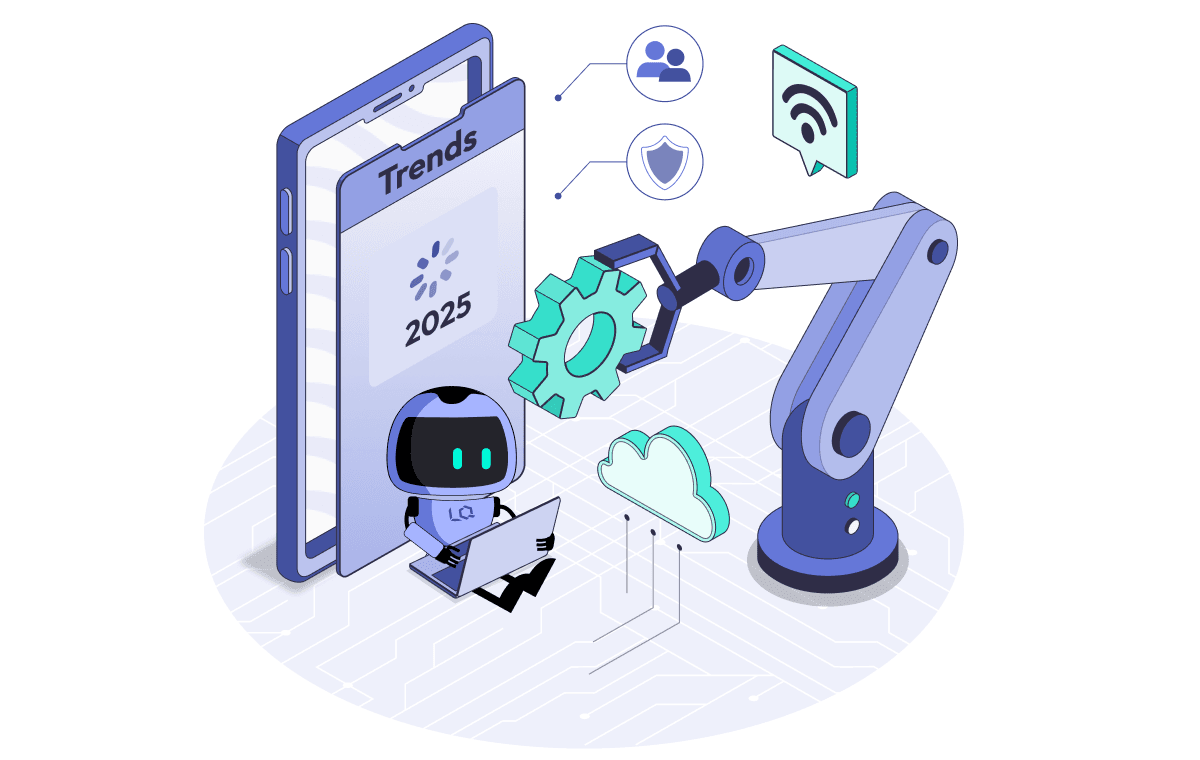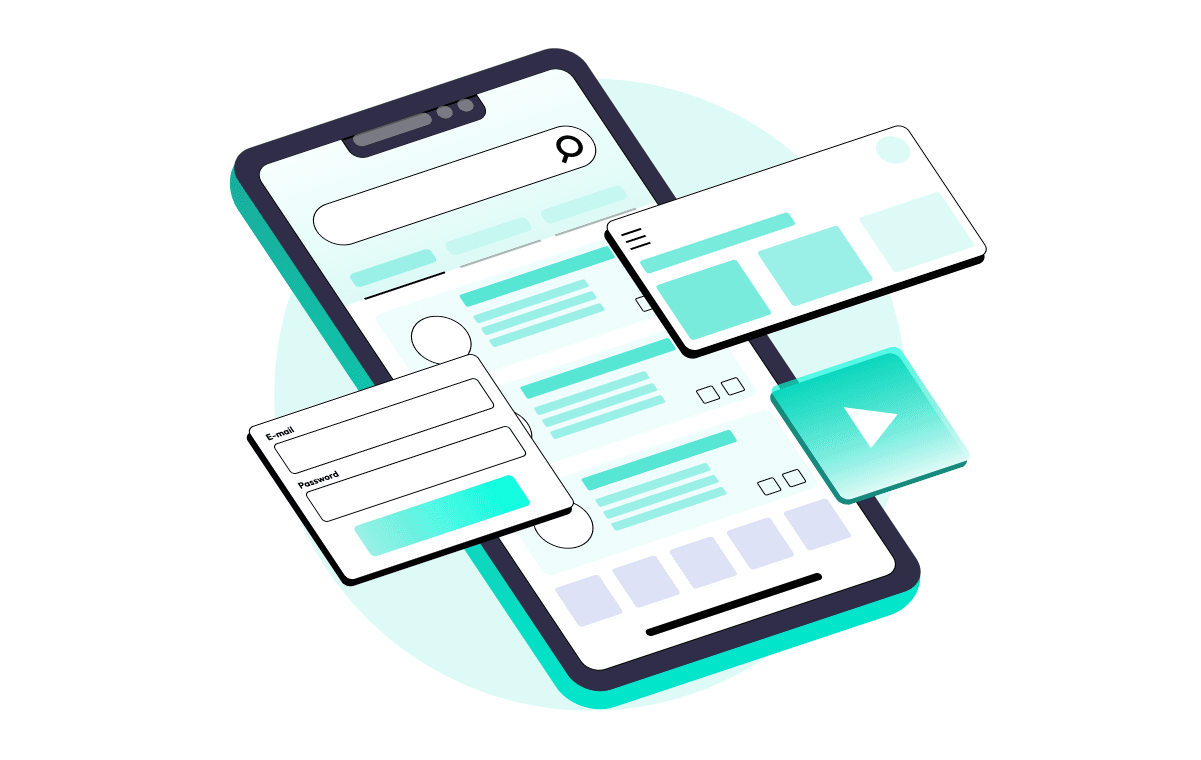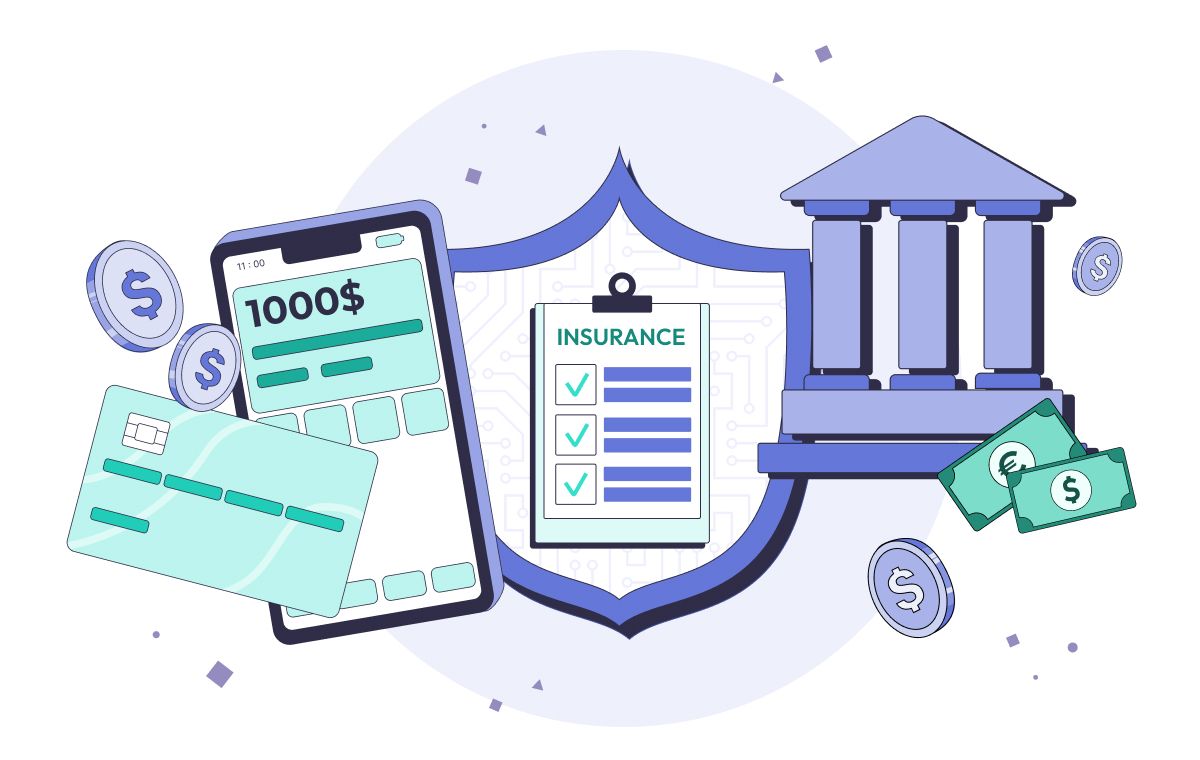Updated Dec 10, 2025 19 min read
Test Automation Trends to Look Out for in 2026
Are you ready to explore the latest trends in test automation for 2026? In this article, you'll discover key insights into cloud-based solutions, AI-driven automation, RPA, and more—transforming how businesses deliver high-quality software. Stay ahead of the curve and learn how these innovations will shape the future of testing!

How will test automation assist businesses in delivering high-quality software products that align with customers' current demands? The following trends need your attention for this year. MarketAndMarkets predicts that the worldwide market for automation testing will develop from its current value of USD 24.7 billion in 2022 to USD 52.7 billion by 2027 at a compound annual growth rate (CAGR) of 16.4%. The current automation testing trends are vital for aligning with the speedily changing testing environment. The following assessment delves into fundamental testing changes and presents test automation patterns and their benefits.
In this article, we will explore the key factors driving changes in testing, provide an overview of test automation trends, and highlight their benefits. Let’s explore the latest trends in test automation that will redefine our understanding and application of automation testing in 2026 and beyond.
What Drives Changes in the Future of Test Automation
Various forces often compel companies to adapt to changes. Let’s explore the factors that shape the future of test automation trends:
1. There is a need to centralize test automation in all changes.
2. We need to update test automation tools to eliminate gaps in the process.
3. Innovative test automation approaches are necessary to achieve our desired results.
4. It is essential to manage the test management process properly.
5. To outperform our competitors, we must thoroughly analyze our software products.
6. We should seek more cost-effective solutions.
7. We need to build a team of versatile specialists who can quickly adapt and easily learn to start automation testing using Agile methodology.
The future of test automation trends hinges on which companies can adopt new approaches and leverage innovative automation testing tools to meet evolving needs and deliver quality software solutions.
Test automation trends for future developments depend on companies that embrace modern approaches through innovative automation testing tools to stay competitive in modern software solution delivery. Implementing emerging automation trends requires organization readiness to maintain leadership against competitors and validate their implementation value for meaningful changes. Automation testing trends for 2026 will primarily concentrate on using security testing within the automated pipeline while also adopting monitoring tools that provide real-time analysis. The evolution of test automation will bring several significant advancements to automation testing in 2026. Here are the key directions to watch out for.
Test Automation Trends 2026: Cloud-Based Test Automation
The cloud-based test automation approach executes automated tests using cloud infrastructure. Cloud testing solutions deliver accessible distributed environments that teams can use on-demand to run tests instead of performing tests on local machines or servers. This method's teams benefit from working with substantial applications, performing cross-platform compatibility assessments, and executing CI/CD pipelines.
Benefits of Cloud-Based Test Automation:
- Parallel execution significantly reduces test cycle times, accelerating release schedules.
- Provides access to a wide range of real devices, browsers, and operating systems without additional hardware investment.
- Cloud-based platforms facilitate collaboration among geographically distributed teams by offering centralized test management and reporting.
- No need to manage on-premise test infrastructure, as cloud providers handle updates and scaling.
Software development needs cloud-based test automation because implementing cloud computing systems can deliver quality products at large scales. Automation testing trends require constant monitoring from QA teams because they determine the effectiveness and efficiency of their practice in the fast-moving technological world.
AI-Driven Test Automation
Software testing processes become optimized by applying AI techniques, such as machine learning and artificial intelligence, which reduces manual work while improving operational efficiency. The systems use predictive abilities to change according to application modifications while automatically building and running test cases and analyzing massive test datasets.
Benefits:
- Reduced maintenance effort: Self-healing capabilities minimize manual intervention in test scripts.
- Accelerated release cycles: Automated test generation and execution reduce testing time, enabling faster deployment.
- Higher accuracy in defect detection: AI-driven anomaly detection reduces false positives and improves test reliability.
- Optimized resource utilization: Intelligent test selection minimizes computational costs by avoiding redundant test execution.
Using AI-driven test automation leads to software testing that becomes more efficient through cost reduction, improved detection of errors, and faster deadline achievement. AI models will gain more significance in test automation procedures following continued improvement. Organizations benefit from test automation latest trends because they remain connected to top industry practices at each level as practices advance in complexity.
Robotic Process Automation
Robotic Process Automation (RPA), also known as software robotics, is another emerging trend in automated testing. RPA allows the simulation of testers' actions when interacting with software. By recording the actions performed by the tester and studying the sequence of test scenarios, RPA can repeat these processes, significantly reducing the time spent on routine tasks. The popularity of RPA is due to its quick integration. Unlike traditional automation, which requires specialized hardware and software, RPA uses bots. These human-controlled bots can be configured using ready-made solutions and trained within a few hours or days, making RPA a cost-effective solution for many companies.
RPA testing methods are already being used across various industries and continue to spread. According to Statista forecasts, the RPA market will grow to $13.39 billion by 2030, a significant jump from $3.17 billion in 2022. Moreover, with artificial intelligence and machine learning development, RPA will become even smarter. This means it will simulate human actions, analyze information, learn from experience, and proactively address issues. In the future, this will allow RPA to perform more complex tasks without constant tester involvement.
Key benefits of RPA:
- Reduction in labor costs through the automation of repetitive test scenarios.
- Minimization of human error risk by accurately replicating tester interactions with the software.
- Significant time and resource savings through the ability to run tests on different systems and applications.
- Scalability, allowing companies to perform tests at any complexity level—from small to enterprise level.
RPA develops business automation testing practices that reach operational excellence by being speedier and less resource-heavy. New automation testing trends within businesses require adaptive test environments, which must become more intelligent to achieve streamlined processes.

Shift-Left Testing: Latest Trends in Test Automation
The uptake of Shift-Left testing by organizations continues to increase because this popular practice shifted its position towards earlier stages of development in 2026. According to the Shift Left principle, testing teams must enter the software development pathway during its initial stages. Organizations benefit from this approach, as testers gain clarity on requirements and software architecture while starting test case development from day one. This approach makes it possible to identify problems early. By fully understanding the product, testers acquire sufficient knowledge to design test scenarios that help their team locate errors before coding starts.

This image illustrates the Shift Left Approach in software development, showing how testing is integrated early in different development lifecycle phases. It highlights that testing is introduced during the requirements, design, coding, and production deployment phases to identify issues sooner and improve overall efficiency.
The numerous benefits of Shift-Left testing remain essential, although this approach is not universally suitable during each project development stage. Tester involvement throughout the development process should depend on the current project status.
Some Benefits of Shift-Left Testing :
- Reduction in development costs through early detection and correction of errors and bugs.
- The ability to automate tests earlier and streamline the entire testing process.
- Faster time to market due to an optimized quality assurance process.
Hyperautomation in Testing
Testing through hyperautomation uses artificial intelligence, machine learning, and robotic process automation (RPA) to automate all possible testing procedures. This method surpasses standard automation capabilities by doing robotic work and automating new automation potential discovery without human supervision. Test case production, fault detection, and decision-making processes become automated tasks within the testing cycle. The ultimate purpose of automation in testing involves accelerating procedures while minimizing human mistakes to boost operational effectiveness by letting teams focus on creative and strategic aspects. Hyperautomation enables testing cycles to reach their release cycle goals while increasing quality standards and enabling scalability.
Let's look at the image, which explains the transition from traditional automation to hyperautomation.

Benefits:
- Increased efficiency: Eliminates repetitive tasks, allowing teams to focus on high-value activities.
- Scalability: Helps manage complex applications with numerous dependencies.
- Comprehensive test coverage: Automates end-to-end testing across multiple platforms. ( You can also explore our automation testing services for scalable, high-quality solutions tailored to your needs.)
Codeless Test Automation
Codeless test automation is a type of test automation in which users can create and execute tests without writing code. The system creates automated tests through its visualization interface, which enables users to develop tests with drag-and-drop operations and recording and playback functionalities. Because of its functionality, non-coding professionals can easily use this solution, including business analysts and QA professionals.
Benefits:
- The drag-and-drop or record-and-playback functionality allows faster test case creation than manually writing code.
- Tests created from visual interfaces simplify application logic and user interface maintenance because they are easier to adapt to changes. Modifying test actions enables easier changes without requiring code rewrite.
- Reducing the reliance on developers for test creation can reduce the cost of automation, especially in teams with limited technical resources.
- These tools are generally easier for new users to learn than traditional programming-based test automation frameworks.
Test Automation for Microservices
Test automation for microservices implements automation methods to validate applications that use microservices architecture. Through their architecture, microservices divide large applications into separate, small, deployable services. The network enables communication between separate services that perform independent, specific tasks. A single service maintains the expected functionality through automated testing while operating independently and providing correct performance within its systemic scope.
Benefits of Test Automation for Microservices:
- Continuous testing: Automated tests are crucial in continuous integration and delivery pipelines, where code changes are pushed frequently. Automation ensures that tests run on every build and deployment. (You can also hire test automation engineers to strengthen your QA team.)
- Quick feedback for developers: Developers receive immediate feedback about the quality of their code changes, allowing them to make adjustments quickly rather than after completing a lengthy development process.
- Cost-effective: Though setting up automated testing can be time-consuming, it saves money in the long run by reducing the cost of manual labor and increasing the speed of development cycles.
Integration of Crowdsourced Testing
Crowdsourced testing is a progressive approach to software QA that engages a diverse community of testers, often from around the world, to test products under real-world conditions on real devices. The great thing about crowdsourcing is that it allows companies to avoid resource constraints. They don’t have to worry about whether the tester has the right test automation tools or skills. Instead, tasks are distributed according to the tester's existing resources, significantly speeding up the market time. The latest trend in crowdsourced testing is its integration with test automation, creating a hybrid approach that combines the scalability and efficiency of automation with the diverse, real-world insights of crowdsourced testing.

The picture above shows the global crowdsourced testing market, indicating that the 2022 market is worth $2.7 billion and is expected to reach $7.9 billion by 2032. From 2023 to 2032, the market will expand at a compound annual growth rate (CAGR) of 11.6% and reach $7.9 billion. Market segmentation shows that large enterprises account for more than 67% of the market, while usability testing accounts for 26% of the market. The market for crowdsourced testing in North America represents over one-third (33%) of the total market value in 2022.
Benefits of Crowdsourced Testing Integration with Automation:
For Companies:
- Broader test coverage: Crowdsourced testers can test on a wider variety of devices, operating systems, and network conditions, providing a better representation of the target user base.
- Cost efficiency: Companies can pay for testing on-demand, only when needed, rather than hiring a large internal team.
- Faster time to market: Automated tests speed up the testing process, and crowdsourcing provides fast feedback from real users, reducing delays.
- Increased flexibility: Crowdsourced testing can scale quickly based on the project’s needs, providing more flexibility than traditional testing teams.
For QAs:
- Diverse experience: Crowdsourced testers gain experience with different types of products and services, as well as different testing tools and methodologies.
- Flexibility in work hours: QAs can choose their working hours, making it an attractive option for those seeking flexible, freelance work.
- Exposure to real-world scenarios: QAs work on various applications under real-world conditions, providing valuable insights into how end-users interact with products.
Scriptless Test Automation
Scriptless test automation is a modern testing practice that simplifies the process by allowing testers to evaluate software quality without writing traditional scripts or code. The tools used in scriptless automation record testers' actions as they interact with the software, and then automatically generate likely use cases for different scenarios based on those actions. This makes it easy for non-technical testers to create and execute automated tests. According to recent industry statistics, companies that utilize scriptless testing tools report a 40% increase in test automation efficiency and a 30% reduction in testing costs.

Benefits of Scriptless Test Automation:
- Faster product delivery: Eliminating the need for manually writing scripts significantly speeds up the testing process, allowing quicker release cycles.
- Higher ROI: Because scriptless automation tools reduce the time and costs of writing and maintaining scripts, companies can see a higher return on investment. The ability to reuse generated tests across different scenarios also contributes to this.
- Flexibility: Even without the complexity of writing detailed scripts, testers can reuse the generated automation scripts across various scenarios and environments, improving the versatility of the testing process.
Blockchain Testing: Latest Trends in Test Automation
Blockchain testing evaluates blockchain systems functionality, security, and performance to ensure they work as intended. As blockchain technology becomes more popular, testing these systems is crucial to prevent errors, security risks, and performance issues in decentralized applications. This trend is gaining momentum as blockchain applications are increasingly used in finance, healthcare, and supply chains.

The image shows a projection of the blockchain market growth from 2023 to 2029, with a Compound Annual Growth Rate (CAGR) of 65.5%.
Benefits of Blockchain Testing:
- Improved security and vulnerability detection: Automated testing helps identify security vulnerabilities, such as 51% attacks, double-spending, and smart contract exploits, before they can be exploited.
- Scalability & performance optimization: Automated load testing ensures blockchain networks can handle high transaction volumes without performance bottlenecks.
- Smart contract validation: Automated testing tools like Truffle, Hardhat, and MythX verify the accuracy, logic, and execution of smart contracts, reducing the risk of costly errors.
- Cost-effectiveness: By automating blockchain testing, companies can reduce manual testing efforts, minimize human errors, and optimize resource usage, making the process more cost-efficient.
Microservices Testing: Latest Trends in Automation Testing
As the number of microservices within an application grows, testing becomes more complex. Traditional testing approaches don’t always work well with microservices, as they need to ensure that individual services and their interactions (APIs, message queues, databases, etc.) function correctly. Since each microservice may be developed using different technologies and can be deployed independently, there are many moving parts to manage. Without a robust testing strategy, defects in one microservice can have cascading effects on others. Additionally, testing across different environments and teams can lead to integration issues.

The microservices architecture market size has grown rapidly in recent years. It will grow from $6.27 billion in 2024 to $15.97 billion in 2029 at a compound annual growth rate (CAGR) of 18.8%.
Benefits of Microservices Testing:
- Isolated component testing: Each microservice can be tested individually without affecting the entire system, reducing risks and making debugging easier.
- Faster Development Cycles: Automated testing enables quicker releases and seamless updates for individual microservices, accelerating the overall development process.
- Parallel development & testing: Multiple teams can work on different microservices simultaneously, leading to faster project delivery.
- Optimized resource utilization: Efficient test execution minimizes computing and infrastructure costs, improving cost-effectiveness.
- Early bug detection: Continuous testing identifies defects early in the development cycle, reducing the cost and effort of fixing them later.
Quantum Computing and Its Impact on Automation Testing
One of the latest trends in automation testing is the integration of quantum computing. Although it is still in its early stages, quantum computing has the potential to revolutionize how we approach automation testing by enabling computational capabilities that far exceed those of traditional systems. With its ability to process massive datasets in parallel, quantum computing opens up new opportunities for testing complex systems with unprecedented efficiency. Quantum computing has already made strides in industries like banking, where it manages fraud and assesses risk. However, its potential applications extend far beyond finance. In automation testing, quantum computing is poised to play a significant role by enabling more sophisticated test scenarios that were previously impossible or incredibly time-consuming with traditional computing power.

Forecast size of the quantum computing market worldwide in 2020 and 2027 in billion U.S. dollars.
Benefits of Quantum Computing:
- Improved precision: The ability to perform highly complex calculations with greater precision means more accurate test results, reducing the margin of error during testing.
- Simulating complex scenarios: Quantum computers can simulate intricate test scenarios, such as multi-variable simulations or optimization problems, which traditional systems struggle to handle. This can result in more comprehensive systems testing involving numerous variables or complicated interactions.
- Reduced testing time: Quantum computing's parallel processing capabilities can significantly reduce the time needed for testing, leading to faster product releases and more efficient development cycles.
Integrating quantum computing into automation testing represents a paradigm shift in how we approach testing complex systems. While it is still early in its adoption, the trend is expected to grow rapidly, with the development of specialized tools and methodologies designed for quantum-powered systems. QA engineers with the necessary skills and knowledge will be at the forefront of this technological revolution, driving the future of automation testing.
Use of AI and ML in Testing: Test Automation Trends 2026
AI (Artificial Intelligence) and ML (Machine Learning) are transforming testing by automating processes and making predictions based on data. These technologies help improve the efficiency and effectiveness of testing, allowing teams to deliver high-quality software faster.
The Artificial Intelligence market reached US$243.72 billion in 2025. It is expected to show an annual growth rate (CAGR 2025-2030) of 27.67%, resulting in a market volume of US$826.73 by 2030.

The Machine Learning market is projected to reach US$113.11 in 2025. It is expected to show an annual growth rate (CAGR 2025-2030) of 34.80%, resulting in a market volume of US$503.41 by 2030.

Benefits :
- Fast test case generation: AI can analyze code and automatically generate relevant test cases, saving time and effort spent writing them manually.
- Automatic test maintenance: As the application evolves, AI and ML can automatically update test scripts when code changes occur, ensuring tests remain relevant and reducing manual maintenance effort.
- Predicting bugs and test outcomes: AI and ML analyze historical testing data to predict the likelihood of software bugs or issues. This helps testers focus on areas with the highest risk of failure, improving test efficiency.
- Faster release: AI and ML can automate repetitive tasks, allowing faster testing and software releases. This leads to shorter development cycles.
Conclusion
AI, cloud technologies, microservices, and hyperautomation will drive automation testing in 2026. These advancements will make testing faster, more intelligent, and more efficient. Companies that adopt these trends will enhance software quality, reduce costs, and accelerate product delivery. Keeping up with these innovations will be essential for QA professionals and organizations striving for excellence in software development.
Need help with test automation? Contact us, we’ll help you implement automation solutions to optimize your testing processes!
Comments
There are no comments yet. Be the first one to share your opinion!
For 8 years, we have helped more than 200+ companies to create a really high-quality product for the needs of customers.
- Quick Start
- Free Trial
- Top-Notch Technologies
- Hire One - Get A Full Team
Was this article helpful to you?
Looking for reliable Software Testing company?
Let's make a quality product! Tell us about your project, and we will prepare an individual solution.
AI-driven tools leverage machine learning algorithms to automatically generate, execute, and maintain test scripts based on application behavior and historical defect data. Unlike traditional frameworks, which rely on manually crafted scripts, AI-driven platforms adapt to application changes (self-healing) and can intelligently predict potential areas of failure. This results in reduced script maintenance, faster release cycles, and a more proactive approach to detecting defects.
Cloud-based test automation enables QA teams to run tests in distributed, scalable environments without investing in on-premise infrastructure. By executing tests in parallel across multiple virtual machines or real devices, teams can accelerate the feedback loop in continuous integration and delivery workflows. This approach simplifies environment setup, reduces maintenance overhead, and provides broader test coverage, which is crucial for applications that must function across various platforms and devices.
Microservices architectures break applications into smaller, independently deployable services, each potentially using different technologies or databases. This complexity arises because each service must be tested in isolation and as part of an integrated system. Effective automation involves implementing granular unit tests, service-level API tests, and contract testing to validate service interactions. Additionally, integration and end-to-end tests ensure the entire ecosystem functions as intended. Tools that support container orchestration (e.g., Kubernetes) and service virtualization are often employed to replicate real-world scenarios and dependencies.
Codeless test automation platforms allow testers to create and execute automated tests via graphical interfaces, drag-and-drop actions, or record-and-playback features. This reduces the learning curve for non-technical team members, accelerates test creation, and lowers maintenance overhead. Because these tools abstract away complex coding tasks, QA teams can focus on designing robust test scenarios rather than debugging automation scripts. This ultimately increases test coverage and speeds up overall delivery cycles.
Hyperautomation extends beyond traditional automation by combining AI, machine learning, and robotic process automation to automate repetitive tasks and complex decision-making processes. In testing, hyperautomation identifies new automation opportunities in real time, auto-generates test cases, and autonomously updates scripts based on application changes. This approach boosts efficiency by minimizing human intervention, enhances scalability to handle intricate application ecosystems, and delivers more comprehensive test coverage for faster, high-quality software releases.




